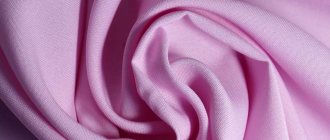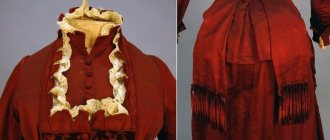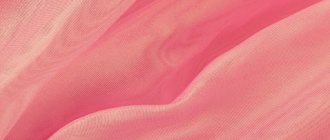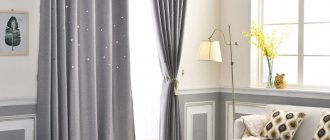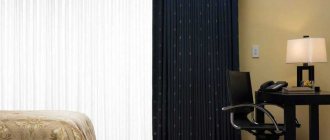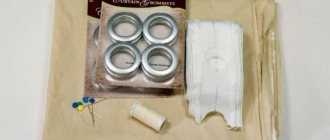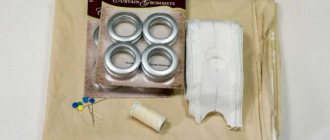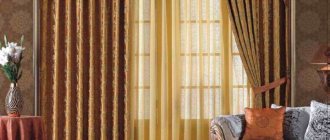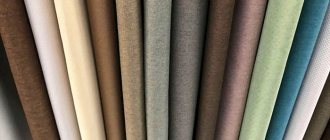History of fabric
Blackout was invented in Finland, the land of white nights. In summer, in Finnish cities located above the Arctic Circle, the sun does not set beyond the horizon for 70 days. At night there is no complete darkness; light constantly enters the windows. In such conditions, it is difficult to fall asleep soundly and get a full night's sleep. The material is designed to provide residents with comfortable sleeping conditions when there is light outside the windows.
The fabric quickly became popular in the global curtain materials market due to its unique properties and high quality.
The name of the fabric is translated from English as “darkening” and reflects the main property of the blackout material: blocking the flow of light into the room.
Roman
Roman blackout blinds
Roman blinds are a functional, comfortable and ergonomic product.
Most often, such curtains are attached to plastic windows, since the design does not require a cornice or baguettes and can be mounted without drilling holes in the wall or in the windows themselves.
Roman blackout blinds allow you to quickly darken a room, and even if the sun is shining brightly outside, by lowering such a curtain, you can achieve complete or almost complete darkness, depending on the light transmittance characteristics of the fabric used.
How it is produced
The material consists of 3 textile layers:
- the surface layer facing the window has a white reflective color;
- a thick protective layer of black polyester is located inside, absorbs light rays and blocks the passage of heat;
- the outer layer is decorative, colored and patterned, affecting the aesthetic perception of the product.
The fibers are tightly intertwined. Satin weaving is often used.
The layers are covered with acrylic foam to achieve maximum light resistance.
Lining fabric for curtains
Dear customers! All our materials are presented in the section “Fabrics for cutting”
Curtains are an important interior detail. They are the ones who create that special atmosphere in the house that we call comfort. Correctly selected curtains perform many useful functions: they combine all the interior details into one style, protect from noise, sun, dust, prying eyes... A wide variety of materials are used for sewing curtains, and the styles can be very bold and intricate: French, classic, Austrian, Japanese... But no matter what fabric and style you choose, you should remember one more very important detail - the lining fabric! The lining not only hides the underside of the curtain, but also gives the finished product additional weight, density and fluffiness. The lining fabric also performs such utilitarian functions as protecting the room from drafts and exposure to ultraviolet rays, it protects the main fabric from contamination and fading... The choice of modern lining fabrics is huge. They are made from both natural and artificial fibers. High-quality lining materials are dense (this allows you to hide the seams), do not deform, and do not wrinkle.
Description of the fabric: properties and composition
Blackout does not allow sunlight to pass through and helps darken the room 100%.
The density of the material ranges from 220-280 g/m2.
The outer surface composition can be satin, satin, polyester, and may contain viscose and acrylic fibers.
According to the method of dyeing, the material is divided into:
- plain - painted in any color, including white;
- printed - with a pattern applied using thermal printing on the surface, the subject of the pattern - any.
Advantages and disadvantages
Pros:
- Does not allow light to pass through.
- Has high sound-absorbing characteristics.
- Thermal insulation – blackout curtains do not allow cold air to pass through.
- Does not burn under certain treatments.
- Does not fade in the sun and does not fade during washing.
- Keeps its shape and does not shrink when washed.
- Has good wear resistance.
- This fabric is hypoallergenic.
- Doesn't wrinkle or stretch.
Minuses:
- Blackout is still synthetic, which can be a disadvantage for fans of natural fabrics.
- The material has a fairly high price.
- Even with all its versatility, the fabric has some design limitations.
Types of fabric
- Blackout original is a standard type of fabric, a kind of standard. Drapes freely, does not wrinkle, is resistant to stains.
- Non-flammable blackout is treated with special compounds that prevent combustion. Processing is possible at the finished web stage. Pre-impregnation of raw fibers is preferable.
- Blackout Street is a material for outdoor use, suitable for printing billboards.
- Blackout linen - additional braiding of the fibers on the front side allows you to create a textured surface that imitates linen.
- Blackout shine - with a flat, smooth surface and interspersed with satin threads.
- Blackout jacquard - with a convex pattern obtained as a result of jacquard weaving on the fabric of the top layer.
Description of fabric
Lightproof material was first produced by the Blackout Almedahls company from Finland. This country has white nights for several months of the year, so Finnish manufacturers were faced with the task of coming up with curtains that would not let in sunlight.
For the production of Blackout, a special technological process is used:
- The fabric is made from three intricately intertwined threads, resulting in a three-layer material.
- The inner layer consists of light-absorbing black polyester threads.
- The outer layers are a decorative surface that is pleasant to the touch and resistant to wear.
- A special acrylic foam is applied on top of the canvas, which has light-proof properties.
- The fabric is then treated with special substances that make it stain-resistant and fire-resistant.
- At the last stage, Blackout is painted or a design is applied to the material.
The result of this production is a dense fabric that has unique properties.
Advantages and disadvantages
The positive properties of the fabric include:
- wear resistance;
- resistance to deformation;
- low creasing;
- color brightness, color fastness;
- drapeability;
- opacity;
- sound-absorbing properties;
- thermal insulation characteristics;
- hypoallergenic;
- environmental friendliness, non-toxic;
- fire safety.
Care instructions
- It is enough to wash the products 1-2 times a year; the fabric is little susceptible to contamination and does not accumulate dust.
- Washing is done in warm water, at a temperature not exceeding 40 degrees. Any washing powder will do.
- Machine washable on delicate cycle.
- Spin is allowed at low speeds, up to 400. The fabric dries quickly and without spinning.
- Things should be dried in the shade.
- Ironing is optional. If it is necessary to obtain a perfectly flat surface when ironing, you should monitor the temperature of the iron; at high temperatures, the fabric will deform.
Rules of care
Read about: Victorian-style curtains: types of materials and decors.
Blackout is considered not a picky fabric. Caring for her will not be difficult. It comes down to washing the product several times a year and ironing as needed. Due to its characteristics, the fabric perfectly repels dust, so it does not need frequent washing.
- The products should be washed at a temperature no higher than 40 degrees, since they are based on synthetic fiber. It is better not to machine spin curtains. The maximum permissible speed is 400. However, even without these manipulations, things dry out quite quickly.
- Blackout curtains practically do not wrinkle, but if ironing becomes necessary, it is better to do it with a warm iron. This will not damage the fiber or destroy the bonds between the layers.
- It is better to dry in natural conditions without exposure to direct sunlight.
Curtains made of blackout fabric are an excellent solution for interior decoration. It not only looks aesthetically pleasing, but also has a number of useful characteristics that residents of northern latitudes will especially appreciate. The material does not transmit light 100%, which allows you to not depend on the time of sunrise and the presence of white nights. Now you know how to choose blackout curtains, and you can fully relax during the night and gain strength for a new day.
All about blackout curtains
Blackout curtains compare favorably with regular curtains.
- They have a long service life: do not fade, do not deform, do not fade over time and under the influence of environmental factors.
- Do not wrinkle during use. After washing, just straighten them carefully and you can hang them.
- They have light-absorbing, heat-insulating, and sound-proofing properties.
- They do not require special care, are easy to wash, do not absorb odors and do not collect dust.
- Do not cause allergies, safe to use.
Sewing custom-made curtains will help you create an individual interior and a unique atmosphere in your home. You can choose any color, original design, or use photo printing.
Curtains are used at home, in offices and conference rooms, public buildings, nightclubs, cafes and restaurants, and darkrooms.
The main types of blackout curtains:
- Roman curtains with pleats go well with curtains.
- Japanese ones are a good solution for panoramic windows, suitable for exotic interiors, original and functional.
- pleated curtains are a combination of dense material and a transparent veil; the window can be completely closed if necessary, ensuring 100% darkness in the room; suitable for non-standard windows.
- Curtains are lush, dense, floor-length fabrics, available in a variety of colors, trimmed with fringe or strict classic ones. Universal, suitable for any interior.
- Rolled panels are straight panels with a lifting mechanism, fit tightly to the windows, are fixed at any height, allowing you to adjust the level of illumination in the room. The principle of operation of curtains: the canvas is rolled into a roll on a special drum, rotated by a cord. Roller blinds vary in the degree of light transmission: from transparent, simply scattering light, to dense, allowing you to plunge into pitch darkness even on a sunny day.
- Inspire Blackout is a heat-resistant, completely light-proof, high-quality roller blind in the mini or standard series.
For the living room, nursery and bedroom, curtains or Roman blinds are well suited. For the kitchen it is better to choose a rolled blackout.
How to choose fabrics for curtains that do not allow light to pass through
Materials of high and medium density do not transmit light: natural, synthetic or mixed. To give even greater density, such curtains can be placed on additional lining material. Let's look at what fabrics can be used for rooms for different purposes, but it's worth noting right away that the ideal option for selecting fabric is to consult a designer or consultant in a curtain fabric store.
Fabrics for curtains in the living room
For the central room, where guests are most often received, curtains made from the following luxurious, visually impressive materials are suitable:
- Velvet is a rich material with a very dense short pile on one side. Velvet is made from cotton or silk threads and viscose. Excellent protection from sunlight.
- Corduroy is a dense, ribbed fabric that drapes well.
- Thick silk does not wrinkle and forms beautiful folds. For additional light protection, a lining is required.
- Tapestry is a woven fabric with patterns or ornaments. Looks good in heavy curtains. Perfectly darkens the room without additional tricks.
- Dense moiré with an iridescent sheen is commonly used in blinds.
- Heavy silk-based brocade with patterns of metallic threads makes magnificent floor-length curtains with soft folds and flounces.
- Damascus is a dense silk jacquard fabric with patterns. Looks good in curtains and blinds.
- Blackout is a modern multi-layer synthetic fabric made from polyester fibers. This is the undoubted leader among lightproof fabrics. Blackout provides 100% light protection.
Fabrics for curtains for the kitchen and dining room
In the dining room and kitchen, curtains, in addition to the aesthetic component, have additional requirements: they should not absorb odors and should be easy to wash. As a rule, the following materials are used to sew curtains for these rooms:
- Canvas is a rough-textured material, durable and inexpensive. Especially popular in modern eco-interiors.
- Cotton with a water-grease-repellent treatment looks beautiful, but fades quickly.
- High-density linen is a tough, durable and wear-resistant fabric. It also fades quite quickly from the sunny side.
- Synthetic polyester fabrics are strong and durable.
- Artificial fabrics made from viscose are breathable and pleasant to the touch.
Fabrics for curtains in the bedroom
Nowhere is light-resistance for curtains more important than in the bedroom. You can sew them from the following materials:
- Cotton needs to be reinforced with a lining to create better light protection. Natural material fades quite quickly from the sunny side.
- Thick silk.
- Blackout is the best option for the bedroom. 100% light impermeability is not indicated for the sake of words. Blackout blocks light 100%.
Fabrics for curtains in the nursery
Materials with bright prints are appropriate for children's rooms. Preference should be given to lightweight, non-staining curtain fabrics that do not collect dust. These are lined cotton, viscose, synthetics.
Customer Reviews
Blackout curtains are recommended by 100% of users. The products delight their owners with high quality and unique properties. They cope with their main task perfectly: the room is dark even when the bright sun is shining through the window. Blackout curtains are most often used in bedrooms and children's rooms. Thanks to them, even children who are early risers stop waking up with the first rays of the sun. The advantage of the fabric is that it is easy to care for and does not require regular washing.
Blackout curtains are suitable for both modern and classic interior design. Original design solutions allow you to create a unique interior. Thanks to its structure, the fabric absorbs sunlight, muffles noise and helps maintain a comfortable temperature in the room at any time of the year. The fabric has many fans around the world and continues to rapidly gain popularity.
Photo gallery
Lightproof curtain fabric
To the children's room
Roller blinds blackout
Pleated
Roman blackout
Printed blackout
Photo printing 3D Roman blackout curtains
Classic
Video: blackout curtain fabric
The video talks about blackout fabric, its characteristics and where it is used. They show what it looks like, what patterns are found and why sunlight does not pass through the fabric. For which curtains is it best to use it?
See similar articles
- Diving - close-fitting viscose fabric
- Bamboo is an eco-friendly fabric for clothing and home textiles
- TOP 5 winter fabrics that retain heat for a long time
- Twill is a durable blended fabric that is soft to the touch.
- Ribana - knitted fabric, natural and tight
- Crepe is a light and durable rough textured fabric.
If you liked the article, share it with your friends!
Right choice
Various photos of blackout curtains can be viewed on the Internet, where you can choose the appropriate option.
Such curtains perfectly decorate the room, they are very convenient to use and quite practical. A large variety of colors makes it possible to choose the appropriate style for any room.
When choosing curtains for the living room, it is best to pay attention to more elegant fabric options that create a festive feeling. Curtains in soft colors are hung in the bedrooms; they should be in harmony with the interior.
Note!
Turquoise curtains: advantages and disadvantages of turquoise colors. Rules for combining turquoise curtains with interior elements. Selection of fabric materials (photo + video)
- Olive curtains: advantages and disadvantages of olive color for curtains. A range of combinations and varieties of shades. Types of olive curtain designs (photo + video)
Curtains for a small kitchen: TOP-140 photos and videos of curtain options for a small kitchen. Tips for choosing length, number of layers, fabric and colors

